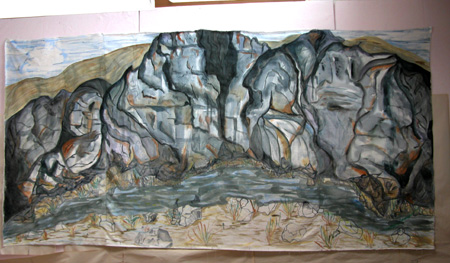Posted by June Underwood on June 8th, 2007
In a small art group that Jer and I belong to, we were given a challenge: for the next meeting, we were each to create some form of art based on “biscuits.” That meeting will be next week. I have to make some art. Using “biscuits” I came up with an anagram: “is Cubist.” I will make a Cubist-style painting, containing biscuits.
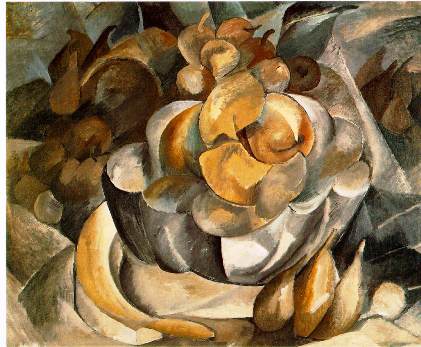
I thought the exercise would be simple. I would look at some Cubist works, get a couple books from the library and raid my bookshelves to see what others had to say, decide on motifs beyond the biscuits, and do a few sketches. Then, I would be ready to paint. more… »
Posted by Angela Ferreira on May 20th, 2007

Title: Give Peace a Chance
Size: 170 x 78 cm
Medium: Oil on Canvas
Description: Art that changes the World!
Posted by Birgit Zipser on May 18th, 2007
To ‘Paint Air’ was the assignment in a painting class at college. Nina’s approach was to paint a chair floating upside down.
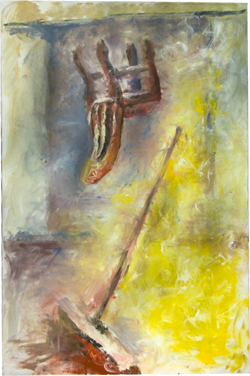
How do you depict air using photography, textile art, drawing or painting?
Posted by June Underwood on May 11th, 2007
Goose Rock Panorama, 2007, Cotton and watercolor, in progress
I’ve been thinking about the planes on which we work, that is, the stretched canvas, the photograph, and the quilted textile. This is partly in response to my interest in analyzing quilted textiles vis-a-vis more traditional media, say, oil paintings. But my thinking has also been triggered by some reading I’m doing; I’ll reference the readings at the end of this post.
With stretched canvas, some questions revolve around how the picture plane is used (as a window, as a flat surface, or extended out into frontal space and rounded so there’s a back side to the image.) more… »
Posted by Richard Rothstein on May 6th, 2007

Last week I postulated that Art Deco as an art movement speaks a distinctly queer language. This week The New York Times asks how openly and assertively gay artists reflect the emergence of gay culture into the mainstream. It’s a fascinating article that speaks very much to the issue of how art both reflects and influences cultural change. While words are one thing, the work itself goes a lot further in answering the questions. What is gay art? What is it reflecting? How is it reflecting and changing gay culture and the culture at large? Rather than talk about the work of the artists discussed in today’s Times, I attempted to visually represent the leading edge of this supposed new school of art. As a gay man I am of course fascinated by this work and its collective messages, but I’m more curious to know what straight men and women think. However, while I look forward to your opinions I would also postulate that even those of you who are “straight” are, as artists, absolutely queer as well, regardless of who you bed so I’m not really sure you can provide a “straight” perspective…nonetheless…


 more… »
more… »
Posted by June Underwood on April 27th, 2007
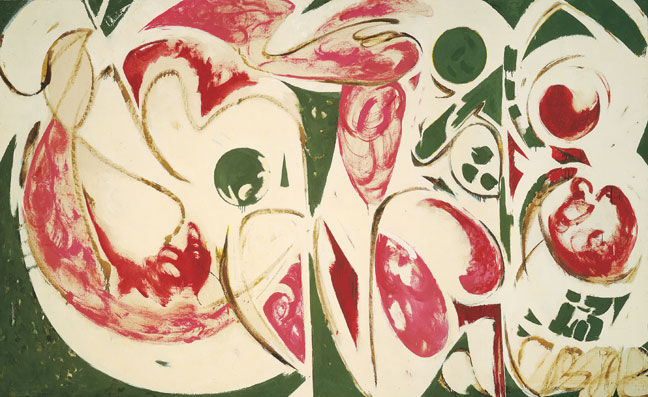
Lee Krasner, The Sun Woman II, 1958, 70 x 114 inches
I thought I’d begin my first official post with a confession.
I love abstract expressionist work. There’s very little of it that doesn’t give me enormous satisfaction.
Why do I love it? more… »
Posted by Karl Zipser on April 24th, 2007

Painting
From Life vs.
From Photos
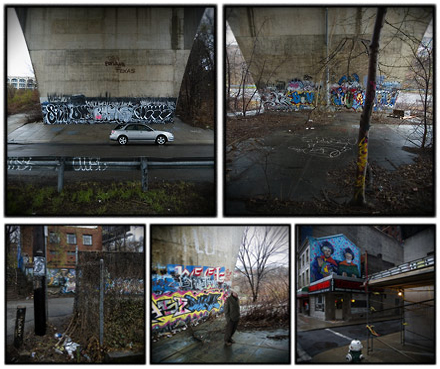
Some graffiti and a mural in Pittsburgh, PA. The mural, lower right, is of Pgh’s 2 Andys – Andy Warhol and Andrew Carnegie – getting their hair and nails done. • The photos can be seen large on my blog
Recently, on my photography blog (The Landscapist), I posted a topic about graffiti – for purposes of this discussion, it might be helpful to read it.
The gist of it was simple – I had just returned from Pittsburgh, PA where the Graffiti Task Force had made what was being billed as the biggest graffiti bust in U.S. history. A lone graffiti artist with over 80 ‘tags’ to his credit is estimated to have caused over $500,000.00 in public and private property damages (keep in mind that, in this case, ‘public’ = bridge abutments and ‘private’ = abandoned structures).
Without going into great detail and for those of you not familiar with Pittsburgh, I will simply sate that the city is awash in visual eyesores which are the inevitable result of the severe economic devastation the area has experienced over the last quarter century. The city keeps trying to rise from the ashes of the end of big steel but it never quite seems to get it right.
The U.S. graffiti community considers Pittsburgh as a target-rich environment, quite possibly the largest ‘canvas’ in the U.S. Many travel here for the abundance of ‘opportunities’ the decaying public and private infrastructure present. The powers-that-be in the Pittsburgh body politic, to include law enforcement, have essentially declared this activity to be a scourge. The ‘miscreants’ need to be hunted down and punished with the full weight of the law.
No effort or, for that matter, consideration has been given to the notion of harnessing this situation for the enrichment of the community. No effort or consideration has been given to the fact that there is a difference between vandals with spray paint and artists with a voice. No effort or consideration has been given to the possibility of turning the area into the Sistine Chapel of the graffiti world.
That said, I am wondering what a diverse group of artists such as the one here on Art & Perception thinks about this situation.




